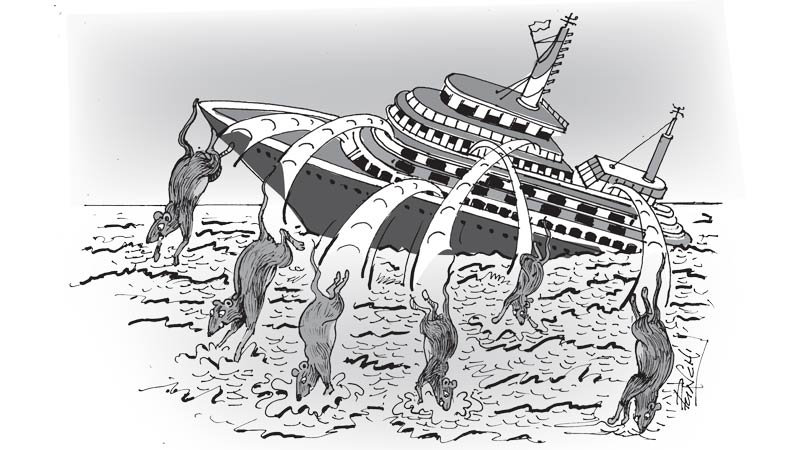 There are various types of animals that destroy the world’s food supplies. Some of them are carriers of dreaded diseases and others are ruthless universal pests. In Sri Lanka we are grappling with a serious problem with monkeys, peacocks and elephants. Being a Buddhist country people are not willing to kill such animals. As a result they have invaded villages posing a major threat to the people and their plantations. More than monkeys, peacocks and elephants, rats are contaminating and destroying our food and spreading diseases. We have not been able to get rid of rats in our homes, fields and factories. They eat almost everything. If they cannot eat something, they will simply nibble through them.
There are various types of animals that destroy the world’s food supplies. Some of them are carriers of dreaded diseases and others are ruthless universal pests. In Sri Lanka we are grappling with a serious problem with monkeys, peacocks and elephants. Being a Buddhist country people are not willing to kill such animals. As a result they have invaded villages posing a major threat to the people and their plantations. More than monkeys, peacocks and elephants, rats are contaminating and destroying our food and spreading diseases. We have not been able to get rid of rats in our homes, fields and factories. They eat almost everything. If they cannot eat something, they will simply nibble through them.
There is a story coming down from the 13th century about two rats that used to cross the henhouse floor towards the nests. There one rat would seize an egg between its forepaws and roll onto its back. The other rat takes hold of the egg, and its snatcher’s tail. Then he drags the other with the egg protectively clutched to his bosom. When they reach their hole they enjoy the egg’s delicious contents.
Rat-borne diseases
Whether you live in the city or village, you will note that the rat is probably the cleverest and most destructive creature on earth. Rats are found all over the world. You will find them near the frozen arctic or blazing deserts. The rat is known for its remarkable instinct for survival. Sometimes rats threaten man with extinction. Rat-borne diseases may have killed more people than those who died in two world wars.
There are more than 500 species of rats. Most of them live in forests and fields away from civilisation. Scientists believe that a few species of rats have decided to live in civilised societies eating nutritious food and posing a threat to man. Rats eat whatever you eat. They know where food is stored and how to eat it when men and women go to bed. The rat has become more domesticated than cats and dogs. Cats of course do not like to see rats in storerooms and kitchens.
In the Middle Ages Europe was overrun by the black rat or roof rat. According to legend, another species of brown rats appeared in 1727. They swam across the Volga River and reached Europe. Thereafter they arrived in England. Being smart animals they hid themselves in ships and reached America in 1775. Norway rats were heavily built and had small ears and thick tails. Although they were big, they could squeeze through small openings or swim at least half a kilometre through flooded sewers. Then they appeared in someone’s house and settled down there.
Being social animals, rats live in colonies. The number of babies in a litter is generally from five to ten. According to some estimates, a single pair of rats could produce 350 million descendants in three years. Exterminators use all kinds of poison to get rid of rats, but they cannot be eliminated easily. When a rat is born, his chisel-bladed incisors or teeth begin to grow.
Eight or ten days after birth, rats file down their sharp teeth continually by chewing anything they come across. If an upper tooth is lost, the bottom one opposite the gap grows through the upper jaw and pierces the brain. We have not heard of such a phenomenon as far as other animals are concerned. Rats gnaw through even electric cables. By doing so they created a blackout in New York City some time ago. With their sharp teeth they find it easy to burrow through sacks of grain, sugar, coffee and flour.
The rat contaminates wherever it goes. It poses a deadly threat to human life. Quite unknown to ordinary people, rats spread 35 different diseases. Their fleas spread bubonic plague which killed a large number of people in Europe in the 14th century. Even today some parts of Africa have become infested with rats. Rat-related epidemics have killed at least 200 million people up to now.
The foraging habits of rats are noteworthy. They are found in homes, offices, hotels, warehouses and sewers. While looking for food they spread deadly germs all over the place. They contaminate food items with their urine and droppings. Many developed countries have been forced to destroy rodent-contaminated foods.
A losing battle
Man has been fighting a losing battle trying to eliminate rats in their homes and factories. Some rats avoid eating poison bait. Sometimes rats sprinkle the poison bait with their urine and faeces. Sometimes we wonder why nature has equipped them with such special characteristics which help them to survive.
Even scientists are baffled by rat intelligence. They carefully avoid all types of traps and poison baits. A century ago, an English zoologist said, “The rat is probably the most injurious and universal pest of the human race.” It does not appear to have a single redeeming feature.
However, the laboratory rat is one of the vital biological weapons in our scientific arsenal. Many lives have been saved by drugs developed and tested on laboratory rats.
Rats have, however, enriched the English language. If you call someone a rat, they will betray their causes to further their own interests. A traitor may be motivated by principles, but a rat is only interested in his own advantage.
A rat-race is a frenzied scramble for promotions in your job. If you smell a rat, you suspect that something is not quite right or you have some grounds for suspicion. Like traitors who desert the losing side in a contest, rats leave a sinking ship. Rats are said to have a premonition when a ship is about to sink and to leave it.









